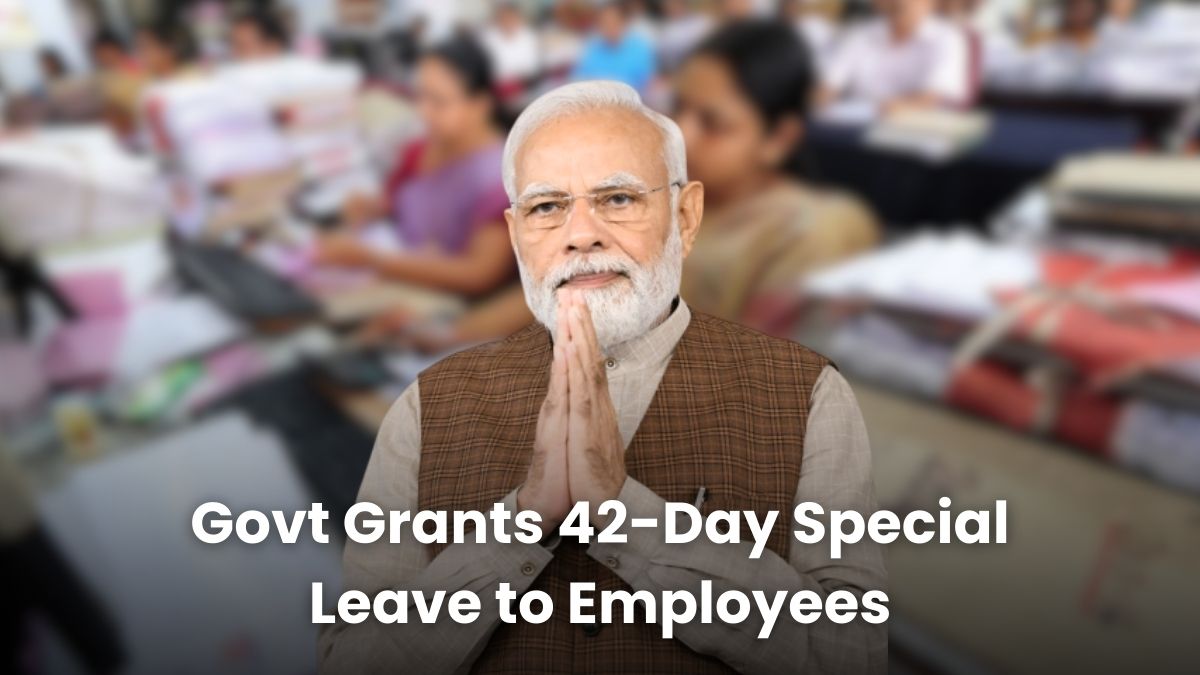Govt Employees Leave – In a big win for government employees, the Department of Personnel and Training (DoPT) has announced a new special leave policy. Under this policy, employees can avail of up to 42 days of paid special leave each year, provided they meet specific conditions. This move is expected to offer much-needed flexibility for employees who are dealing with significant family responsibilities, particularly when caring for dependents with disabilities. Let’s dive into what this new leave rule means and how it can benefit you.
What Is the New Special Leave Rule?
The new rule introduced by the DoPT grants up to 42 days of paid special leave to central government employees in certain circumstances, mainly for caregiving duties related to dependents with disabilities. This provision is part of the government’s ongoing effort to promote inclusivity and provide better support for employees facing challenging personal situations.
Key Features of the DoPT Order
Here are the main highlights of the new special leave policy:
- 42 days of paid special leave available in a calendar year.
- The leave can be taken in full or in parts, based on the employee’s needs.
- The leave applies to employees taking care of dependents with benchmark disabilities, as defined under the Rights of Persons with Disabilities Act, 2016.
- There is no requirement to use other types of leave, such as Earned Leave (EL) or Half Pay Leave (HPL), before applying for this special leave.
Who Can Avail of This Leave?
This leave is available to central government employees who meet the following criteria:
- The employee must be a central government staff member.
- They must be responsible for the care of a family member who has a benchmark disability (defined as a disability of 40% or more).
- The employee must be actively involved in providing care for the dependent.
- Proper documentation, including a medical certificate or disability certification, must be provided to validate the claim.
Purpose and Benefits of This Special Leave
The new special leave is designed to help employees who are balancing both their professional responsibilities and the caregiving needs of a dependent family member. It offers significant benefits for those in caregiving roles, as it provides additional time off without affecting their salary.
Here are the key reasons why this leave is important:
- Care during critical medical treatment or rehabilitation: Employees can take time off to ensure their dependent receives the care they need during medical treatments or recovery.
- Personal care during tough times: Caregivers can offer support during challenging periods when their dependent needs constant attention.
- Improved work-life balance: This leave helps employees manage their personal and professional lives better, without the stress of losing income or job responsibilities.
How to Apply for This Leave?
To apply for this special leave, employees will need to follow their department’s regular leave application process but with a few additional steps:
- Submit a written request: The employee must submit a formal request for leave to the relevant authority in their department.
- Attach supporting documents: This includes the dependent’s disability certificate and any medical justification for the caregiving role.
- Await approval: Once the request and documentation are reviewed, the leave will be approved by the competent authority.
- Take leave in parts or full: Employees can choose to take the leave in a single stretch or split it based on their needs.
Comparing the New Special Leave with Other Leave Types
Here’s how this new special leave compares to other leave options available to government employees:
| Leave Type | Total Days | Paid/Unpaid | Specific Purpose | Documentation Needed |
|---|---|---|---|---|
| Earned Leave (EL) | 30-60 days | Paid | General purpose | Basic leave application |
| Half Pay Leave (HPL) | Unlimited | Half Salary | Medical or personal reasons | Medical certificate |
| Maternity Leave | 180 days | Paid | Childbirth | Medical certificate |
| Child Care Leave | 730 days | Paid | Childcare (up to 18 years for female employees) | Proof of child’s age |
| Special Disability Leave | 120 days | Paid | Disability from service-related injury | Medical certificate |
| New Special Leave | 42 days | Paid | Care of a dependent with benchmark disability | Disability certificate |
How the Leave Impacts Work-Life Balance
The introduction of this special leave is a positive step toward enhancing the work-life balance of employees. By providing additional time off without losing income, it allows employees to focus on their caregiving duties without the added stress of work commitments. This support can go a long way in reducing the mental and emotional toll on employees who are managing both work and caregiving roles.
Encouraging Inclusivity in Government Workplaces
This new policy encourages inclusivity by recognizing the importance of caregiving and the role it plays in supporting families with special needs. By providing dedicated leave for this purpose, the government is fostering a more supportive and understanding work environment. This move also helps reduce burnout and stress among employees who are already juggling demanding personal and professional lives.
Which Departments Are Implementing the Rule?
The DoPT has issued instructions to all central ministries and departments to implement this new leave rule. Here’s a quick look at the implementation status across various departments:
| Department/Ministry | Implementation Status | Roll-Out Date |
|---|---|---|
| Ministry of Home Affairs | Immediate | Already active |
| Ministry of Defence | Immediate | Already active |
| Ministry of Education | In Progress | Within a week |
| Ministry of Health | Immediate | Already active |
| Ministry of Railways | Immediate | Already active |
| Department of Posts | In Progress | Under review |
| Other Central Govt. Departments | To be notified | Within 15 days |
This new leave rule marks a significant and compassionate step toward supporting government employees who are caregivers for dependents with disabilities. It allows them to fulfill both family and work obligations without worrying about losing income or job security. This initiative promotes a better work-life balance and encourages a more inclusive environment in government workplaces.




